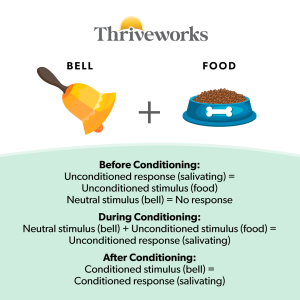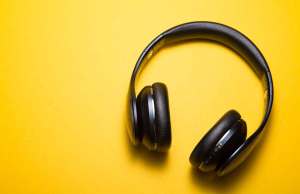
- A conditioned stimulus is an object, person, place, or item that becomes associated with a certain response through repeated exposure. This process involves pairing the unconditioned stimulus with a particular response or impulse, resulting in the creation of a conditioned response.
- Examples of a conditioned stimulus and conditioned response include a barista responding to a bell ringing at a coffee shop, knowing a customer has entered, or a hotel concierge reacting to a customer ringing a bell at the front desk.
- An unconditioned stimulus automatically causes a response without prior learning, while a conditioned stimulus prompts a learned response after being associated with an unconditioned stimulus.
- Frequent and repeated exposure to an unconditioned stimulus can lead to the development of a conditioned stimulus. Effective conditioning requires repeated exposure to a stimulus with the same response each time, as well as the immediate pairing of the conditioned and unconditioned stimulus.
We may not realize it, but we interact with a variety of conditioned stimuli on an average day, from getting up when the school bell rings to stopping at a red light in traffic. Conditioned stimuli can be created knowingly or unknowingly, but all elicit certain impulsive actions based on an associated stimulus.
Learn more about the differences between a conditioned stimulus and an unconditioned stimulus, as well as how they work together to cause a conditioned response.
What Is the Meaning of “Conditional Stimulus”? What Is a Conditioned Stimulus?
A conditioned stimulus is when a certain response (for example, leaving the classroom) becomes associated with a previously neutral object, item, person, or place (for example, a bell ringing). A neutral, also referred to as unconditioned, stimulus can become a conditioned stimulus either intentionally or unintentionally.
This process works by repeatedly pairing the neutral stimulus with the unconditioned stimulus–something that causes an automatic response–until they are associated with one another and evoke the same response. At this point, that response is considered a conditioned response.
Conditioned stimuli develop over time and require a repeated pairing of two specific stimuli and a specific response or impulse. It’s possible, and even quite common, for individuals to have multiple conditioned responses to stimuli in their environment. It’s also possible to undo the conditioned stimulus-response pairing.

What Is an Example of a Conditioned Stimulus?
A good example of a conditioned stimulus can be found when you enter a coffee shop and there’s a bell above the door. The barista hears the bell and knows that a customer is present and requires service. The barista engages in an action because of the bell (stimulus), such as saying a greeting. They aren’t reacting to the bell itself, but what the bell now signifies to them — a customer entering the shop.
In this example, the bell is the conditioned stimulus, the customer entering the shop is the unconditioned stimulus, and the greeting is the conditioned response.
What Is an Example of a Conditioned Response?
A conditioned response is a learned response that has been paired with a conditioned stimulus. An example would include a hotel concierge walking to the front desk after a customer has rung a bell.
In a famous psychology experiment known as Pavlov’s Dog, psychologist Ivan Pavlov trained his dog to associate the ringing of a bell with being fed. Quickly, the dog developed a conditioned response of salivating when he heard the bell, despite the fact that it had not been presented with food.
What Is a Conditioned vs. Unconditioned Stimulus?
An unconditioned stimulus leads to an automatic response without any prior learning or thought on the part of the subject. Examples include your eyes watering while cutting an onion or salivating at the smell of your favorite food.
A conditioned stimulus, on the other hand, only produces a reaction from a person after they have learned to associate the stimulus with a specific (usually unrelated) outcome. Think of a cat running to you when they hear a can open, because they’ve learned to associate the sound of an opening can with their dinner.
A conditioned stimulus is something that has the capacity to create a paired response, and often, is something that the person has been exposed to frequently and repeatedly. An unconditioned stimulus can elicit a directly-related response.
Not all unconditioned stimuli will lead to someone developing conditioned stimuli, but repeated and frequent exposure paired with a neutral stimulus can increase that likelihood.
What Are Examples of a Conditioned Stimulus and an Unconditioned Stimulus?
Again looking at the Pavlov’s Dog experiment, there are three important elements: the bell, the food, and the reaction of salivating.
In this scenario, salivating is the conditioned response. This means that the conditioned stimulus is the bell, as it eventually elicits the conditioned response. The unconditioned stimulus is then the food, as it directly causes the reaction of salivation and is paired with the bell in order to associate the two.
What Makes a Good Conditioned Stimulus?
Certain factors strongly influence and strengthen the relationship between a stimulus and its conditioned response. For example, repeated exposure to a stimulus with the same response following it each time has a high likelihood of creating a conditioned stimulus-response. To make the conditioning most effective, the person needs to be exposed to the unconditioned stimulus quickly after being exposed to the conditioned stimulus.
Further, having a high risk and/or reward for engaging in some sort of response behavior associated with the stimulus significantly increases the strength of that conditioned stimulus-response.













